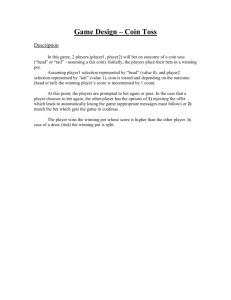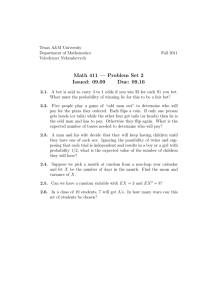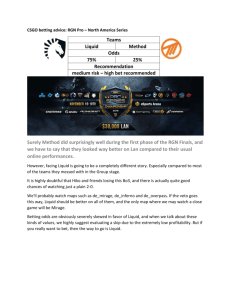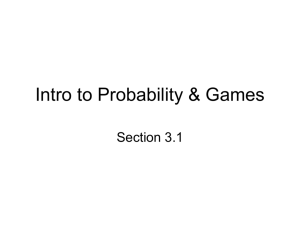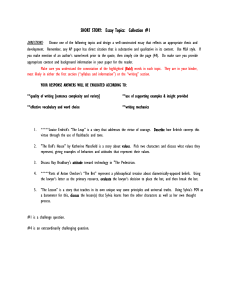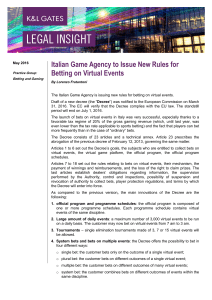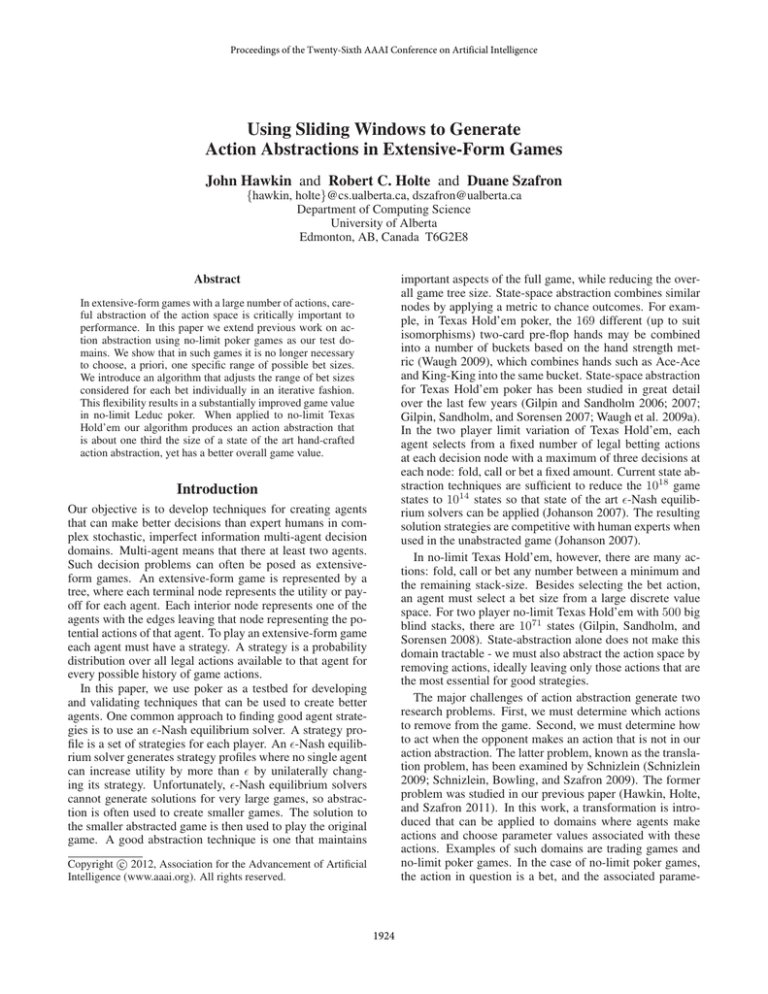
Proceedings of the Twenty-Sixth AAAI Conference on Artificial Intelligence
Using Sliding Windows to Generate
Action Abstractions in Extensive-Form Games
John Hawkin and Robert C. Holte and Duane Szafron
{hawkin, holte}@cs.ualberta.ca, dszafron@ualberta.ca
Department of Computing Science
University of Alberta
Edmonton, AB, Canada T6G2E8
Abstract
important aspects of the full game, while reducing the overall game tree size. State-space abstraction combines similar
nodes by applying a metric to chance outcomes. For example, in Texas Hold’em poker, the 169 different (up to suit
isomorphisms) two-card pre-flop hands may be combined
into a number of buckets based on the hand strength metric (Waugh 2009), which combines hands such as Ace-Ace
and King-King into the same bucket. State-space abstraction
for Texas Hold’em poker has been studied in great detail
over the last few years (Gilpin and Sandholm 2006; 2007;
Gilpin, Sandholm, and Sorensen 2007; Waugh et al. 2009a).
In the two player limit variation of Texas Hold’em, each
agent selects from a fixed number of legal betting actions
at each decision node with a maximum of three decisions at
each node: fold, call or bet a fixed amount. Current state abstraction techniques are sufficient to reduce the 1018 game
states to 1014 states so that state of the art -Nash equilibrium solvers can be applied (Johanson 2007). The resulting
solution strategies are competitive with human experts when
used in the unabstracted game (Johanson 2007).
In no-limit Texas Hold’em, however, there are many actions: fold, call or bet any number between a minimum and
the remaining stack-size. Besides selecting the bet action,
an agent must select a bet size from a large discrete value
space. For two player no-limit Texas Hold’em with 500 big
blind stacks, there are 1071 states (Gilpin, Sandholm, and
Sorensen 2008). State-abstraction alone does not make this
domain tractable - we must also abstract the action space by
removing actions, ideally leaving only those actions that are
the most essential for good strategies.
The major challenges of action abstraction generate two
research problems. First, we must determine which actions
to remove from the game. Second, we must determine how
to act when the opponent makes an action that is not in our
action abstraction. The latter problem, known as the translation problem, has been examined by Schnizlein (Schnizlein
2009; Schnizlein, Bowling, and Szafron 2009). The former
problem was studied in our previous paper (Hawkin, Holte,
and Szafron 2011). In this work, a transformation is introduced that can be applied to domains where agents make
actions and choose parameter values associated with these
actions. Examples of such domains are trading games and
no-limit poker games. In the case of no-limit poker games,
the action in question is a bet, and the associated parame-
In extensive-form games with a large number of actions, careful abstraction of the action space is critically important to
performance. In this paper we extend previous work on action abstraction using no-limit poker games as our test domains. We show that in such games it is no longer necessary
to choose, a priori, one specific range of possible bet sizes.
We introduce an algorithm that adjusts the range of bet sizes
considered for each bet individually in an iterative fashion.
This flexibility results in a substantially improved game value
in no-limit Leduc poker. When applied to no-limit Texas
Hold’em our algorithm produces an action abstraction that
is about one third the size of a state of the art hand-crafted
action abstraction, yet has a better overall game value.
Introduction
Our objective is to develop techniques for creating agents
that can make better decisions than expert humans in complex stochastic, imperfect information multi-agent decision
domains. Multi-agent means that there at least two agents.
Such decision problems can often be posed as extensiveform games. An extensive-form game is represented by a
tree, where each terminal node represents the utility or payoff for each agent. Each interior node represents one of the
agents with the edges leaving that node representing the potential actions of that agent. To play an extensive-form game
each agent must have a strategy. A strategy is a probability
distribution over all legal actions available to that agent for
every possible history of game actions.
In this paper, we use poker as a testbed for developing
and validating techniques that can be used to create better
agents. One common approach to finding good agent strategies is to use an -Nash equilibrium solver. A strategy profile is a set of strategies for each player. An -Nash equilibrium solver generates strategy profiles where no single agent
can increase utility by more than by unilaterally changing its strategy. Unfortunately, -Nash equilibrium solvers
cannot generate solutions for very large games, so abstraction is often used to create smaller games. The solution to
the smaller abstracted game is then used to play the original
game. A good abstraction technique is one that maintains
c 2012, Association for the Advancement of Artificial
Copyright Intelligence (www.aaai.org). All rights reserved.
1924
remaining chips, it is called an all-in bet. After the first betting round, a number (depending on the poker variant) of
community cards are revealed and another betting round occurs. Further community cards and betting rounds can occur, depending on the poker variant. If no player folds before
the end of the last betting round, each player makes a poker
hand using their own cards and the community cards and the
highest ranked poker hand wins the pot. If there is a tie, the
pot is split.
ter is the size of the bet. In addition to this transformation,
this paper introduces an algorithm to minimize regret in the
transformed game. After finding a strategy that minimizes
regret, the strategy can be mapped to an action abstraction
of the no-limit game. This paper showed that such abstractions select the same bet sizes as Nash-equilibrium strategies
in small poker games and that this technique produces better strategies than -Nash equilibrium strategies computed
from manually selected action abstractions in no-limit Leduc
poker.
The algorithm introduced in our previous work (Hawkin,
Holte, and Szafron 2011) defines a bet size range for each
bet action and selects a bet size from that range. The same
range was picked for all bets, based on expert knowledge,
and the problem of selecting good ranges was ignored. We
extend this work here by considering the choice of ranges
in detail. First, we show that range choice is essential in
creating a good action abstraction. Second, we show that
selecting appropriate ranges is a non-trivial problem: there
are practical reasons why large ranges cannot be used, and
in general no single small range is appropriate. Third, we
demonstrate a method of automatically selecting ranges using multiple short runs of a regret-minimizing algorithm
similar to the one used in our previous paper (Hawkin, Holte,
and Szafron 2011). This range-selection technique generates better abstractions than our previous algorithm in nolimit Leduc poker, while using ranges that are 3.5 times
smaller. Fourth, we show that our action abstraction performs better than state of the art hand-crafted action abstractions used in two player no-limit Texas Hold’em agents that
are about three times larger than the abstractions generated
by our technique.
Solving for bet sizes
Our previous work (Hawkin, Holte, and Szafron 2011) introduces a bet-sizing algorithm for generating action abstractions in no-limit poker. In that work we outline a transformation that is applied to two player no-limit poker that creates
a new game with extra agents, which we call the bet-sizing
game throughout this paper. A regret minimization algorithm is then applied in order to compute strategy profiles
for the bet-sizing game. The strategies of the extra agents
can then be mapped to bet sizes for the no-limit game, creating an action abstraction.
The bet-sizing game retains useful properties of the bigger
game while reducing memory requirements. The transformation is defined as follows. At every tree node where betting (or raising) is a legal action, all bet actions, except all-in,
are replaced by a single bet action with no amount specified
and all child nodes are coalesced into a single node. In addition, a new subtree with three nodes is inserted between the
betting node and the coalesced node. The new subtree belongs to a new agent called a “bet-sizing” agent, who has two
actions: low bet, denoted L, and high bet, denoted H. This
transformation is illustrated in Figure 1, which is adapted
from our previous work (Hawkin, Holte, and Szafron 2011).
The “bet-sizing” agent privately chooses either the low or
high bet action, both of which lead back to the coalesced
node. No other agent knows which action was taken. A new
bet-sizing agent i is introduced at each decision point in the
game, so the values of Li and Hi can be different for every
bet-sizing agent i, with the constraint that Li < Hi . Note
that Li and Hi are expressed as pot fractions: L = 0.75
means a bet size of three quarters of the current pot. We will
refer to the two agents that have fold, call, bet and all-in actions as players one and two, or the “main players”, and the
extra agents as “bet-sizing” agents.
Although the bet-sizing transformation can be applied to
bets for both main players, it could be applied to one player’s
bets, while the other player uses a fixed betting abstraction.
Previously we picked a single L value and a single H value
for the entire tree. This paper addresses the question of how
to pick values of L and H that allow us to generate action
abstractions for one player which maximize value against
a particular, pre-determined action abstraction of the other
player. The effective bet size is defined as (Hawkin, Holte,
and Szafron 2011)
Rules of heads up no-limit poker
We apply our techniques to two player no-limit poker games.
Each player starts with a fixed number of chips known as a
stack. There are two variations. In one variation each player
puts the same number of chips in the pot, called an ante.
In the other variation player one puts chips in the pot (the
big blind) and player two puts half as many chips in the pot
(the small blind). In the ante variation player one acts first
in each round, while in the blinds variation player two acts
first in the initial betting round and player one acts first in
all subsequent rounds. At least one private card is dealt to
each player, sometimes more depending on the poker variant
being played.
Once the ante or blinds are posted, a betting round occurs. During this betting round a player may fold (surrender the pot), check/call (match any outstanding bet, referred
to as check if there is no bet to match), or bet/raise (match
any outstanding bet and increase it). If the blind variation is
used, the small blind acts first and faces an outstanding bet,
which is the size of the small blind. If the ante variation is
used, the first player to act faces no outstanding bet. The
betting round continues until: one player folds, both players check or one player bets and then the other player calls.
The bet size is selected by the betting player, with minimum
size equal to the maximum of the big blind and the last bet
increase made during the current round. If a player bets all
B(P (H)i ) = (1 − P (H)i )Li + P (H)i Hi .
(1)
This is the expected value of the bet size made by bet-sizing
agent i using strategy P (H)i .
1925
T
we developed a metric, Ri,|·|
, that ranks bet importance. The
T
Ri,|·| value measures the utility that could be gained, after T
iterations, by moving bet i.1 The third, fifth and seventh
columns of Table 1 show the bet sizes of the 10 bets with the
T
highest Ri,|·|
values. We can see that while 8 of these bets
were very close to L = 0.8, two bet sizes moved towards
H = 1 over the first 8 million iterations. These two bets had
T
the highest and third highest Ri,|·|
values.
The game value of the abstractions created changed significantly during the first 8 million iterations, while these
important bets were moving. During the final 192 million iterations, however, the game value stayed relatively constant.
This result, coupled with the fact that there are important
bets at both ends of our range, suggests that allowing some
of the bets to go lower and others to go higher may result in
increased game value. The simplest way to achieve this goal
is to continue using static ranges, but make them larger. Unfortunately, as we explain in the next subsection, there are
significant disadvantages to using large ranges.
(a) Regular no-limit game
(b) Bet sizing game
Figure 1: Decision point in a no-limit game, and the betsizing game version of the same decision point.
Length
1m
4m
6m
8m
10m
20m
100m
200m
0.80 − 0.82
All
Top 10
Bets
Bets
152
8
151
8
150
8
145
8
142
8
138
8
126
9
126
9
0.82 − 0.98
All
Top 10
Bets
Bets
8
2
9
2
9
1
13
0
16
0
20
0
31
0
28
0
0.98 − 1.0
All
Top 10
Bets
Bets
0
0
0
0
1
1
2
2
2
2
2
2
3
1
6
1
Tree creation - the small range constraint
When creating the game tree for the bet-sizing game, there
are two issues:
• What ranges do we use?
• How many bets do we allow in each bet-sequence (what
is the depth of the game tree)?
Consider an abstraction of a no-limit poker game with initial stacks of 15 big blinds, where only half-pot and pot bets
are legal. Figure 2 shows the betting tree. Each node is labeled by the pot size in big blinds after the agent to act has
put in chips to call the outstanding bet, but before adding
the raise chips. For example, the root node (player two) is
labeled 2 since when player two is about to raise, player one
has already put in the big blind and player two has put in
both the small blind (0.5 big blinds) and another 0.5 big
blinds to call (as a prerequisite to making the raise action)
for a total pot of 2 big blinds. The right child node contains 6 big blinds, since if player two raises by the pot (2 big
blinds), the pot would then contain: the current pot (2), plus
the raise (2), plus the amount that player one would need to
add (2) before adding the next raise amount.
In this game the players can make three half-pot bets, two
pot bets, or two half-pot bets and one pot bet, before an additional bet would require more than the 15 big blinds in the
initial stack. For example, to follow the node labeled 16 by
a half-pot bet would require player one to add 8 chips to the
pot after having put 16/2 = 8 chips into the pot, requiring
an initial stack of 16 big blinds. If we transform this game
to a bet-sizing game with L = 0.5 and H = 1 everywhere,
do we construct a game tree with depth 2 bets or 3 bets?
Figure 3 shows the betting tree in the bet-sizing game,
where the bold edges indicate the third bet in any betting sequence. The dotted ovals represent information sets, since
after the bet-sizing agent makes their private action, none
Table 1: Bet sizes after different length runs.
The case for variable ranges
In this section we show that when the algorithm introduced
in our previous paper (Hawkin, Holte, and Szafron 2011)
is applied to large games such as no-limit Texas Hold’em,
there is much value to be gained from using different L and
H values at different points in the tree.
We applied the bet-sizing transformation, with L = 0.8
and H = 1 (suggested by experts) for all bets, to a small card
abstraction of no-limit Texas Hold’em with 200 big blind
stacks. We modified the algorithm from our previous work
(Hawkin, Holte, and Szafron 2011) and applied it to the first
player, obtaining a new agent whose game value exceeded
the best game values of fold call pot all-in agents by ≈ 17%
percent after 200 million iterations. The second, fourth and
sixth columns of Table 1 show the number of bet sizes in the
given range after different length runs.
Table 1 shows that the vast majority of bet sizes are <
0.82, which is surprising, given that previous expert knowledge dictated that if only a single bet size is used everywhere, it should be pot sized. So many bet sizes being close
to the low boundary after only 1 million iterations suggests
we should move the range lower. It’s possible, however, that
the bets with these small values have little effect on the game
value (for example those betting decisions could be reached
with extremely small probability). To test if this was the case
1
1926
See the appendix for more details
and the preferred bet size can move lower towards the new
L. If the algorithm favors a larger bet size, we need to increase both L and H, which allows the preferred bet size to
get larger, while decreasing the tree size.
Variable range boundaries
Table 1 suggested that our expert-informed choice of fixed
[0.8, 1] ranges in our Texas Hold’em strategy computation
was likely suboptimal, since the bet sizes for the most important bets hit the range boundaries. Some bets should be
smaller than 0.8 and others should be larger than 1. However, we showed in the previous section that large ranges
[L, H] cause problems due to variable sized betting sequences. Our approach is to minimize the impact of tree
size variation by fixing the size of the range, while moving
the two range boundaries.
Instead of running the algorithm for many iterations (200
million) with a single fixed range, we do a series of short
runs (a few million iterations). We start with a single default
range [Ld , Hd ]. We initialize all ranges to this default range
on the first short run, using Hd to determine how many bets
are allowed in the tree. At the end of the run, we change
all ranges so that the new range for a particular bet is the
same size as the old range, but is centered on the bet size
computed by the algorithm during that short run. Therefore,
if a bet size for any bet hits a range boundary or was near
to a range boundary at the end of a run, the bet size will be
able to move further in that direction on the next run. If for
any bet H increases to the point that it is larger than an allin bet size, we reduce H to the all-in bet size and set L to
accommodate the fixed range size. If L decreases so that it
is smaller than the minimum bet size for any bet in the tree,
this bet is removed from the tree. If the H values along any
bet-sequence decrease enough to add a bet of size Hd to that
sequence, we add a bet using the default range [Ld , Hd ].
Each time a short run completes, we obtain a set of bet
sizes, which we use as our new betting abstraction. We
measure the quality of this new abstraction in the usual
game-theoretic way - we apply an -Nash equilibrium solver,
such as CFR (Zinkevich et al. 2007), and obtain an -Nash
equilibrium. We then obtain best responses to this strategy
profile for both players, and this gives us upper and lower
bounds on the game value of our new betting abstraction.
A best response is a strategy for one player that maximizes
that player’s expected utility when played against a specific
fixed strategy of the other player. To answer the question of
how well our variable-range bet-sizing algorithm performs,
we go through this process after every short run and plot the
resulting upper and lower bound best response curves.
Figure 2: Betting tree for a 15 big blind stack game, with an
abstraction that allows only half pot and pot bets.
Figure 3: Betting tree for a bet-sizing game transformation
of a 15 big blind stack game, allowing two bets not including
the bold actions, or three bets if bold actions are included.
of the other players know the resulting pot size. Unfortunately, if we include three bet-sequences in the tree, some
of the sequences are invalid. For example, three pot-size
bets result in a pot size of 54 chips, where each player has
contributed 27 chips, which is 12 more chips than the initial stack size. Alternatively, if we create a tree of depth 2,
then some legal bets are missing from the tree. For example, it is legal to bet half-pot or pot after two half-pot bets.
If these actions are missing from our tree, our strategy may
not be able to take advantage of a bet action that results in a
higher game utility. Unfortunately, the legality of the third
bet is dependent on the size of the previous bets and this
information is hidden by the information sets. The disparity between the shortest and longest legal bet-sequence size
is dependent on the size of the betting range so it can be
minimized by selecting small ranges, but cannot be eliminated in general. Therefore, to avoid making invalid bets
we use the H value to select the tree-depth. If the algorithm selects many small bets, it may not be able to select as
many small bets as are possible in the full game, unless we
have some way of changing the tree size to allow more small
bets. Recall that in the previous section we saw the importance of allowing bet sizes to increase or decrease beyond
fixed range boundaries. Therefore, we need small ranges
that can change dynamically while the strategy computation
algorithm is running. In addition, if the algorithm favors a
smaller bet size, we need a mechanism for reducing both L
and H so that the tree size gets larger (due to a smaller H)
Algorithmic changes
The algorithm introduced in our previous paper (Hawkin,
Holte, and Szafron 2011) was based on CFR, a widely used
algorithm for computing -Nash equilibria in poker games
(Zinkevich et al. 2007). CFR is an iterative self-play algorithm that uses regret matching to adjust probabilities every
iteration. The algorithm from our previous work uses CFR
1927
value of the pot-size abstraction by 21% and 9% for players one and two respectively, as compared to the fixed-range
algorithm with 12% and 7.7% gains. When we used more
than 10 short runs, the game value deviated by at most 1%.
Our variable-range algorithm can out perform a fixed-range
algorithm, even when the width (0.7) of the fixed range is
larger than the width (0.2) of our variable ranges. The generated betting abstractions contained many important bet sizes
outside the range [0.8, 1.5] - for the 10 million iteration run
T
of player one, 3 of the top 4 bets, as ranked by Ri,|·|
, were
greater than 1.5.
We also applied our technique to an unrestricted Leduc
game, with 200 big blind stacks. Using the same ranges and
short run lengths, the abstractions we created improved over
a betting abstraction that makes only pot sized bets by ≈
30% and ≈ 43% for player one and player two respectively.
for players one and two, but for the bet-sizing agents the
strategy is updated according to2
(
(t−1)sti +srit+1
if t < 10000
t+1
t
si =
(2)
(9999)sti +srit+1
otherwise.
10000
where sti is the effective bet size made by bet-sizing agent
i on iteration t defined as B(P (H)i ) from Equation 1, and
srit+1 is the effective bet size on iteration t + 1 as computed
by an unmodified CFR algorithm. In CFR, the average (not
the current) action probabilities converge to an -Nash equilibrium. Therefore, for each action sequence the algorithm
maintains a sum of the probability this sequence was played
each iteration. Any time a player has 0% probability of
reaching an information set, the addition step can be skipped
for all action sequences that reach the subtree beneath that
information set. This cutoff can always be used, independent of how the bet-sizing agents are updated. Therefore,
we now introduce an alternative equation for updating the
bet-sizing agents:
(
st+1
i
=
sti +
sti
+
Bit (srit+1 −sti )
t
Bit (srit+1 −sti )
10000
if t < 10000
Texas Hold’em
Finally we applied our methodology to 200 big blind nolimit Texas Hold’em poker. We abstracted the state space of
the game using the hand strength metric (Waugh 2009) with
5 buckets each round and perfect recall of past actions. This
led to an abstraction with 5 buckets on the pre-flop, 25 on
the flop, 125 on the turn and 625 on the river. While imperfect recall is often used in Texas Hold’em state abstractions
(Waugh et al. 2009b), we used perfect recall to facilitate
analysis, as it is intractable to calculate best responses in imperfect recall games. Again [0.8, 1] was used as the starting
range for all bets.
In the Texas Hold’em experiment described by Table 1
most bets were close to an edge of their range after 1 million
iterations, with the 10 most important bets being close to an
edge within 8 million iterations. With this result in mind we
tried short runs of various lengths, from 2 to 10 million iterations. We found that while 2 million iterations was not
enough, 8 and 10 million iteration runs had very similar results, with 10 being marginally better. All of the results we
discuss below use short runs of length 10 million iterations.
We found that for both players, the game value of the
abstractions we obtained would initially increase after each
short run, eventually levelling off. We used 8 runs for player
one and 6 runs for player two. The game value of these
abstractions improved over a betting abstraction that makes
only pot sized bets by ≈ 48% and ≈ 88% for player one and
player two respectively.
Good no-limit agents typically use at least two bet sizes
in their abstractions - usually pot and half pot. Since half
pot bets are small, they increase tree depth, so the number of half pot bets is usually restricted (Schnizlein 2009;
Gilpin, Sandholm, and Sorensen 2008). We created a number of betting abstractions that use unrestricted pot bets, plus
one half pot bet, once per round on specific rounds. These
fixed bet agents can be compared to the agents generated by
our bet-sizing algorithm. The abstractions were made asymmetrically - only one player was given extra half pot options.
These abstractions and our generated abstractions are listed
in Table 2, along with the number of (I, a) pairs (edges in
the game tree) they contain. The number of extra (I, a) pairs
due to added half pot bets does not depend on which player
(3)
otherwise
Here Bit is the probability all players play to reach this
information set. Equation 2 updates sti for each bet sizing
player on every iteration. If Bit = 0 then Equation 3 implies
that st+1
= sti . In this case, the algorithm can make a single
i
strategy update pass for each team of bet-sizing agents at the
same time that it updates the totals used to calculate the average strategy of the corresponding main player. In tests of
the algorithm, where Equation 2 was replaced by Equation 3
and a few other optimizations were made at the coding level,
the results were equivalent within a few percent. However,
the changes resulted in a speedup of 3 times on smaller poker
games and as high as 100 times on Texas Hold’em. We used
Equation 3 to generate all of the results in this paper.
Empirical results
In our previous work (Hawkin, Holte, and Szafron 2011) we
applied the bet-sizing game transformation to a restricted
form of no-limit Leduc poker with a cap of two bets per
round and starting stacks of 400 antes. Using L = 0.8 and
H = 1.5 everywhere, a betting abstraction was generated
whose game value was greater than the pot-size betting abstraction by 12% and 7.7% for players one and two respectively. With a two bet per round cap and large stacks, the
tree-size problem described in this paper was avoided. The
betting sequence length is at most 4 bets and the starting
stack is large enough to make 4 bets of 1.5 pot each.
We applied our variable-range algorithm to this game,
with default values of L = 0.8 and H = 1 for all bet sizes.
Using short runs of length 2, 4, 6, 8 and 10 million, our
abstractions all converged within 10 short runs, beating the
2
There was an indexing error in the original equation from our
previous paper (Hawkin, Holte, and Szafron 2011), which has been
corrected here.
1928
Name
P OT
HP F
HF
HT
HR
HF T R
P 18
P 26
Pot fractions in abstraction
1
1, 0.5 once on pre-flop
1, 0.5 once on flop
1, 0.5 once on turn
1, 0.5 once on river
1, 0.5 once on flop, turn and river
Our agent, player 1, 8 runs
Our agent, player 2, 6 runs
# (I, a) pairs
1,781,890
3,867,090
3,820,140
3,646,890
3,143,140
9,115,390
2,930,050
3,121,775
and rounded to the nearest 0.1, is shown in Figure 5. We can
see that no one bet size is preferred - a variety of bets from
0.2 to 1.5 are used. The important bet sizes are different
for each player - P 18 ’s range from 0.2 to 0.7 along with a
couple of large bets > 1, while P 26 ’s vary from 0.4 to 1.
Table 2: (I, a) pairs in 5 bucket Hold’em abstractions.
has the added bets. The amount of memory used by CFR is
proportional to the number of (I, a) pairs.
We used CFR to compute upper and lower bounds on the
game value between a player using each abstraction in Table 2 and a fold call pot all-in player. Figure 4 shows the
results for some of the abstractions that were used for player
two. The Y-axis represents big blinds won by player two.
The bounds are very tight - for the basic P OT abstraction a
run of about 200 million iterations would in practice be considered long enough to produce an acceptable . To obtain
these bounds we ran the CFR algorithm for between 2 and 4
billion iterations on each of the bet-sizing abstractions and 5
billion iterations on each of the other abstractions. Abstractions HT and HR are not included in the plot as they were
only slightly better than P OT .
Figure 5: Distribution of important bet sizes for abstractions
P 18 and P 26
Conclusion
We have shown that when the approach introduced in our
previous paper (Hawkin, Holte, and Szafron 2011) is used
to abstract the action space of extensive-form games, the
choice of L and H values throughout the tree is of utmost importance. It is, in fact, more important to choose
these ranges correctly than it is to find exact values within
them. Our approach of using multiple short runs of a regretminimizing algorithm, followed by adjustments of all L
and H values, creates action abstractions in no-limit Texas
Hold’em that are both smaller in size and better in game
value than current state of the art action abstractions.
The generated abstractions use a wide variety of bet sizes,
with the most important ones ranging from 0.2 to 1.5 pot.
This result shows the complexity of the action space of nolimit Texas Hold’em, and the need for further work on action
abstraction in similar domains. The tendency to use different bet sizes in different situations also has a practical advantage over action abstractions that use a small number of
bet sizes. When creating a game-theoretic agent to operate
in this domain, the designer must decide on a small set of bet
sizes for opponent agents. The large variety of bet sizes used
by the agents we created ensures that game-theoretic opponents will have to rely heavily on dynamic translation during
matches. Creating such problems for opposing agents is an
advantageous property of any action abstraction.
Figure 4: Bounds on game values of various betting abstractions for player two against a fold call pot all-in player one
As shown in Figure 4, abstraction P 26 out performs all
other abstractions, beating HF T R by ≈ 19% after 6 short
runs. For player one, abstraction P 18 had bounds on its
game value very close to those of HF T R , and easily beat the
rest of the abstractions (not shown in Figure 4). Additionally, we can see from Table 2 that abstractions P 18 and P 26
are about one third the size of HF T R . Smaller betting abstractions are always favoured over larger ones with similar
value, as this allows for refinement of the state abstraction.
HF T R is a state of the art action abstraction - it was designed
to have restrictions on half pot bet usage identical to those
of the winning entries in the no-limit instant run-off division
of the 2010 and 2011 computer poker competition.3
A histogram showing the distribution of the top 10% of
T
bets for abstractions P 18 and P 26 , ranked according to Ri,|·|
3
Acknowledgements
We would like to thank the members of the University of
Alberta Computer Poker Research Group for their valuable insights and support, and Compute Canada for providing the computing resources used to run our experiments.
This research was supported in part by research grants from
the Natural Sciences and Engineering Research Council of
Canada (NSERC), the Alberta Informatics Circle of Research Excellence (iCORE) and Alberta Ingenuity through
the Alberta Ingenuity Centre for Machine Learning.
http://www.computerpokercompetition.org/
1929
Appendix - Importance metric
Gilpin, A.; Sandholm, T.; and Sorensen, T. B. 2007.
Potential-aware automated abstraction of sequential games,
and holistic equilibrium analysis of Texas Hold’em poker.
In AAAI, 50–57.
Gilpin, A.; Sandholm, T.; and Sorensen, T. B. 2008. A
heads-up no-limit Texas Hold’em poker player: Discretized
betting models and automatically generated equilibriumfinding programs. In AAMAS, 911–918.
Hawkin, J.; Holte, R.; and Szafron, D. 2011. Automated
action abstraction of imperfect information extensive-form
games. In AAAI, 681–687.
Johanson, M. 2007. Robust strategies and counterstrategies: Building a champion level computer poker
player. Master’s thesis, University of Alberta.
Schnizlein, D.; Bowling, M.; and Szafron, D. 2009. Probabilistic state translation in extensive games with large action
sets. In IJCAI, 276–284.
Schnizlein, D. 2009. State translation in no-limit poker.
Master’s thesis, University of Alberta.
Waugh, K.; Schnizlein, D.; Bowling, M.; and Szafron, D.
2009a. Abstraction pathologies in extensive games. In AAMAS, 781–788.
Waugh, K.; Zinkevich, M.; Johanson, M.; Kan, M.; Schnizlein, D.; and Bowling, M. 2009b. A practical use of imperfect recall. In Proceedings of the Eighth Symposium on Abstraction, Reformulation and Approximation (SARA), 175–
182.
Waugh, K. 2009. Abstraction in large extensive games.
Master’s thesis, University of Alberta.
Zinkevich, M.; Johanson, M.; Bowling, M.; and Piccione,
C. 2007. Regret minimization in games with incomplete
information. In NIPS, 1729–1736.
Each iteration, the bet-sizing agents minimize immediate
counterfactual regret (Zinkevich et al. 2007). We compute
two values:
R(L)ti = uti (L) − uti (sti )
(4)
and
R(H)ti = uti (H) − uti (sti )
(5)
These two equations are the utility differences for bet-sizing
player i betting H or L on iteration t instead of the current
effective bet size sti = B(P (H)ti ). If increasing sti gains
value, then R(H)ti > 0 and R(L)ti < 0. The opposite is true
if decreasing sti gains value. Since all other probabilities are
fixed during regret computation, R(H)ti is linear in sti . This
is true because the amount of money that is won or lost, uti ,
is linear in sti . Therefore, the magnitudes of these values are
proportional to the distance sti is from the range boundaries.
For example, as sti gets closer to H, |R(L)ti | increases and
|R(H)ti | decreases proportionally. Therefore, we define
t
Ri,|·|
= |R(L)ti | + |R(H)ti |.
(6)
The larger this value is, the more utility we stand to gain by
moving this bet. Finally, we define
T
Ri,|·|
=
T
X
t
Ri,|·|
(7)
t=1
References
Gilpin, A., and Sandholm, T. 2006. A competitive texas
hold’em poker player via automated abstraction and realtime equilibrium computation. In AAAI, 1007–1013.
Gilpin, A., and Sandholm, T. 2007. Better automated abstraction techniques for imperfect information games, with
application to Texas Hold’em poker. In AAMAS, 1168–
1175.
1930

